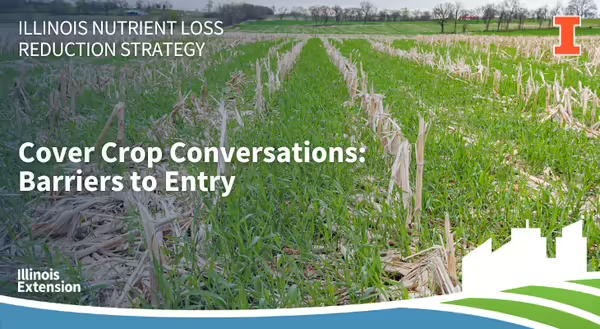
In a virtual panel hosted by Illinois Extension, three farmers from across the state discussed their experiences with cover crops. Norm Deets of Ogle County, Brian Corkill of Henry County, and John Pike of Williamson County reflected on the successes, challenges, and lessons learned as they worked to implement cover crops into their operations.
Goals and successes
For Norm, cover crops began as a strategy to keep soil and nutrients in the field. He saw that using cereal rye was a way to hold on to nitrogen and phosphorus that might otherwise move downstream, while also building soil health.
For Brian, the starting point for implementing cover crops was issues with erosion. Heavy rains and bare soil made it clear that he needed something to protect his fields year-round. Over the years, he has found that cover crops have also improved the soil structure and water infiltration.
John Pike emphasized that cover crops are a flexible tool with many different uses. For example, farmers might plant them for erosion control, compaction relief, or nutrient cycling. He explained that the key is to be clear about your goals and to match your approach to them.
Challenges and lessons learned
While they are all strong advocates for cover crops, they also discussed the learning curve that comes with adopting cover crops into an operation. They revealed that getting seed established after harvest can be tricky in wet or late falls. In addition, the farmers highlighted that termination ahead of corn takes some adjustment, and poorly timed management can be a setback. Another important note was that cover crops can also pull moisture in a dry spring, which makes timing essential.
Even with the challenges, the farmers all agreed that the benefits of cover crops have been worth it. Norm said that he no longer spends as much time fixing gullies and washouts after heavy rains. Brian has noticed that his fields take in water more quickly and hold up better in both wet and dry years. He also sees more earthworms and faster residue breakdown, signs that soil biology is improving.
John added that these kinds of changes don’t happen overnight, but cover crops take time to build soil health that is more resilient to Illinois weather.
Advice for farmers new to cover crops
The panelists offered several key takeaways for farmers just getting started:
- Start small
- Find someone local you can go to for advice
- Don’t get discouraged; cover crops are a long-term investment
- Tailor your approach: match management to your goals and conditions
To listen to the entire conversation, check out the recorded webinar. To find farmers in your area who have adopted cover crops or another agricultural conservation practice, go to the Illinois Sustainable Ag Partnership’s Conservation Story Map.
About the authors
Rachel Curry is an Agriculture and Agribusiness Educator specializing in agriculture and watershed education, and she is part of the Illinois Extension's Nutrient Loss Reduction Strategy implementation team. She holds a B.A. in Environmental Studies from Knox College and an M.S. in Environmental Science and Soil Science from Iowa State University, focusing on soil fertility. Her work centers on education and outreach related to the Illinois Nutrient Loss Reduction Strategy, promoting agricultural conservation practices that reduce nutrient loss while enhancing water quality and soil health across Illinois.
Nicole Haverback serves as a Watershed Outreach Associate and is an Illinois Extension team member implementing the Nutrient Loss Reduction Strategy. She holds a B.S. in Agricultural and Rural Policy Studies from Iowa State University. In her role, Nicole coordinates watershed management efforts aimed at reducing nutrient losses in two nitrate-nitrogen priority watersheds, offers expertise on best management practices to minimize nutrient loss, and leads outreach initiatives promoting agricultural conservation practices outlined in the Illinois Nutrient Loss Reduction Strategy.
Luke Zwilling serves as a Watershed Outreach Associate and is an Illinois Extension team member implementing the Nutrient Loss Reduction Strategy. He grew up on a farm in Jasper County and earned a B.S. in Agriculture and Biological Engineering from University of Illinois. Luke coordinates watershed-based activities to reduce nutrient loss in two phosphorus priority watersheds, provides expertise on best management practices for nutrient loss reduction, and conducts outreach on agricultural conservation practices in the Illinois Nutrient Loss Reduction Strategy.
About the blog
At Illinois Extension, we’re working to improve water quality at home and downstream. Every month, our Watershed Outreach Associates will bring you stories highlighting agricultural conservation practices, current research projects and results, and from the field farmer interviews. The Nutrient Loss Reduction blog covers conservation practices recommended by the Illinois Nutrient Loss Reduction Strategy, timely updates, farm safety, and new decision tools to help farmers and producers reduce the nutrients leaving their fields.